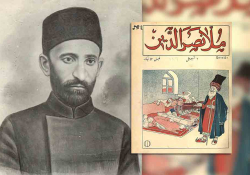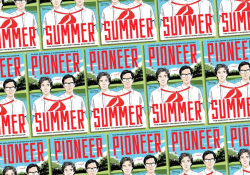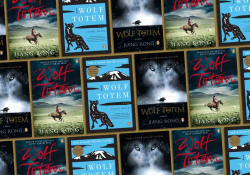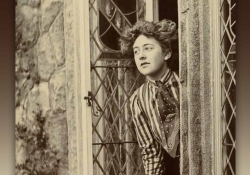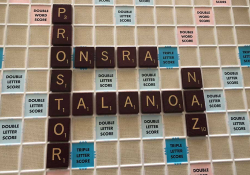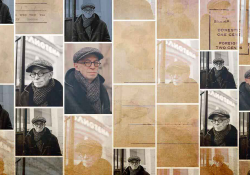Retranslating Kafka
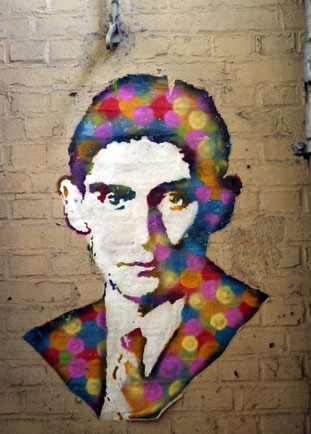
Later this year, Bloomsbury will release Michelle Woods’s newest book, Kafka Translated. This will be the first book-length study about translating Franz Kafka’s work. WLT talks with Woods about translating Kafka’s style, his humor, and even his image. The Marx Brothers, David Foster Wallace, and Federico Fellini? But of course. How can you talk about Kafka without them?
Michelle Johnson: Your previous book-length translation study was about Milan Kundera. What drew you to such a comprehensive study of Kafka?
Michelle Woods: It is completely Milan Kundera’s fault that I’ve been writing about Kafka—even despite Kundera’s grouping of Kafka scholars as rather dim-witted “Kafkologists”! His essays on Kafka in The Art of the Novel and Testaments Betrayed—especially in his essay “A Sentence,” about three French translations of one sentence in The Castle—caused me to go back and re-read Kafka and drew my interest in thinking about the issue of translation with Kafka. The essay is, in fact, as much about Kundera’s experiences with his editors as it is about Kafka (though Kundera blames translators for problems such as introducing fancy language or synonyms, in his case, it was often the editors who changed and domesticated his novels). What is centrally important about the essay—though it seems on the surface to be a translator-bashing essay—is his attempt to argue that there are translatable elements that are often not translated because of domestic tastes and publishing pressures. In translation studies, we’ve been focusing mainly on the untranslatable, on trying to fight the myths of fidelity and betrayal, but Kundera presents a cogent argument for thinking about the translatable mechanics of the text, focusing on how words are used rather than what they are. Kundera is also especially good at conveying the humor in the novels; it made me go back and read them (in disbelief that they were funny, but he was right!).
My second book, Censoring Translation, was mainly about Václav Havel, whose plays were hugely influenced by Kafka (and, of course, Beckett)—The Memorandum comes straight out of the memo story told by the Council Chairman in The Castle. Havel thought a lot about how we use language and how language uses us, and I think that really opened up a reading of Kafka for me.
MJ: Reading the translators’ notes, I see a continuing theme: translators look back to and build upon earlier translations. Is every new Kafka translation a product of accretion?
MW: I think that the translators are very aware of their predecessors, partly because many of the re-translators are also Kafka scholars and have thought about the issue for a while and would be very aware of earlier translations. But from interviews with Mark Harman and Michael Hofmann (and from talking to translators in general), I got the impression that they kept other translations out of mind while doing the translation work. One thing that I argue in the book is that translators are formed as literary beings by their particular history of reading—and that these texts in fact probably have more influence on the translation than other Kafka translations (Mark Harman, for instance, went back to Beckett’s Trilogy when translating The Castle, and you see the affinities there).
MJ: Is this awareness of those who’ve gone before typical in literary translation, or is it particularly pronounced when translating Kafka and, perhaps, other writers of time-tested classics?
MW: I think that translating a classic author must be more intimidating, and there is certainly more expectation and pressure; translators seem to be more aware of their potential critical audience as well as a more general readership. Their re-translations are always going to be compared to other, earlier translations. I argue that the problem, though, lies in a very traditional way of reviewing translations—with the critic setting him/herself up as an arbiter of a better or worse translation choice. What was fascinating in writing the book, and when taking into account the backgrounds and interests of particular translators and the editorial pressures they faced, was how certain things that were deemed mistakes or mistranslations were, in fact, logical choices and, in comparing different translations, comparing those choices really opened up a reading of the text itself. In other words, instead of being a negative competition, a comparison of the translations, looking at the different translation solutions, brought you back to thinking about how to interpret Kafka.
MJ: In his translator’s note to The Man Who Disappeared (America), Ritchie Robertson addresses some of the dilemmas he faced translating Kafka’s style, for instance retaining the author’s simplicity despite frequent word repetition and striking a compromise between sentence clutter and a sparser-than-Kafka style. What are the most significant conflicts of style when translating Kafka, and how do you think they are best resolved?
MW: Milan Kundera wrote an excellent essay on this called “The Sentence,” in which he talks about the importance of this plain language, the long sentences, the repetitions in Kafka and how understanding this “personal style” is a fundament to understanding Kafka and his aesthetics. Kundera looks at three different French translations of one sentence and argues that their domestications of the style of Kafka’s text show a misunderstanding of what Kafka tried to do with language, that is, in transgressing “good style” in his own language without being a flagrant stylist like Joyce or Faulkner.
The repetitions are central to the humor and the beauty of the prose: there is a great example in Amerika—Karl is miraculously picked up on the boat by his wealthy uncle, who installs him in his skyscraper apartment, and Kafka conveys the modernity of the “iron” building and New York through a constant repetition of things that Karl is getting used to: a paragraph where he constantly talks about the balcony, then one where he constantly repeats the word “desk” (talking about the mechanical desk in the apartment), then another where he repeats the word “piano,” then “English” when his uncle raps a rhythm on the table as he tries to recite an American poem, and he is then brought to the telegraph room where we see mechanized communication—this wondrous, scary, funny mechanical world is conveyed through this very subtle but mechanical repetition.
MJ: Describing his translation of a collection of stories, Stanley Corngold wrote, “I have avoided translating Kafka’s plain phrases with colloquial expressions more vivid than his own. You can understand the temptation to give a colorful, colloquial bounce to a certain luminous plainness in Kafka’s prose.” Do translators of Kafka have to exercise particular restraint?
MW: There’s a world of difference in Kafka’s style to some of his contemporaries: for instance, Gustav Meyrink sets a chapter of his gothic novel, The Golem, in a cathedral (clearly very like the St. Vitus Cathedral) that is complete expressionist gothic—over the top, lugubrious, sensational, lyrical wordiness. Less than ten years later, Kafka’s “In the Cathedral” chapter from The Trial is a different animal—you still very much see the play of darkness and light, but it’s a matter-of-fact, almost uninterested tone (which makes it funny). At one point, Josef K. takes out a pocket torch (flashlight) and looks at a painting with it and thinks he sees a knight, but is terribly disappointed when it turns out to be a religious painting and sits back down, putting the flashlight into his pocket—the flashlight had only just been invented, but this new technology is no more use for illumination (physical and metaphysical) than a candle. But K. doesn’t care anyway. When the priest then tells him the “Before the Law” parable, K. reacts very matter-of-factly and they have a pages-long discussion about what it means (which lends the parable a lot of humor). If you made the language more dramatic or lyrical it would tip the novel into melodrama or tragedy.
Also, everyone forgets that the reason K. is there in the first place is because he’s acting as a translator for an Italian businessman whom he can’t understand because the Italian’s bushy moustache is in the way, and all K. wants to do (instead of interpreting) is sniff it!
MJ: In an essay for Harper’s, David Foster Wallace writes about teaching Kafka, particularly Kafka’s humor: “the particular sort of funniness Kafka deploys is deeply alien to kids whose neural resonances are American.” Might translators feel tempted to update and Americanize Kafka’s expression—translate his humor—when working on American translations of his work?
MW: I give my students the DFW essay the first Kafka class they take because you have to persuade them that Kafka is funny, and part of it relates to a dominant (and mostly cinematic or televisual) idea of what funny is. Wry, dark, ironic central European humor is not necessarily on their radar (wait till they hit middle-age!). And yet, a lot of Kafka’s humor is quietly slapstick with some connection (possibly through Yiddish theater) to vaudeville and silent movies (Kafka was a movie-goer when he wrote Amerika). For instance, the opening scene of The Trial has Josef K. handing the guards a bicycle license and then, later, he physically acts out his arrest scene to impress Fräulein Bürstner. Kundera says Philip Roth suggested the Marx Brothers should play the characters, and I think you can see that physical humor. I usually show the stateroom scene from A Night at the Opera when my class reads “The Stoker”—the opening chapter of Amerika, but Robinson in Amerika being wrapped up in bandages and pedestrians just hopping over him, and Karl being chased by the police are other examples.
The three recent translators of Amerika have mainly used British English—with a deliberate decision not to translate in American slang in order to convey the estrangement of the immigrant in Amerika—so, Karl becomes a “lift-boy” not an “elevator-operator.” I think it adds to the humor—the sense we’ve all had being abroad of not quite being au fait with the culture, even if we speak a little of the language. A little of Karl’s polite incredulity is conveyed.
MJ: You’ve written the first book-length discussion of Kafka translation. While researching the book, what did you find most fascinating?
MW: Without doubt finding out about the translators, which meant archival research in Scotland and Prague and interviewing contemporary translators: Mark Harman and Michael Hofmann. They all have fascinating histories and approaches. Willa Muir’s archive was especially moving—she clearly felt she had been elided from literary history and gets increasingly despondent in her journals about her legacy. She claimed, privately, that she in fact did most of the work on the Kafka translations but felt the literary world was too sexist to believe it. As she moved into her fifties and sixties, she seemed to feel more and more invisible, at the same time writing candidly about her sex life and aging. It made me feel very strongly that she needed some recognition, and I really hope at the very least the book does that.
What I love about writing about translation is that you get to talk about historical and social contexts and literary history, but you also get to read an author at very close range—you can get excited by Kafka’s colons and semi-colons!—and relate the details to the bigger picture. It makes you very appreciative of the intricacy of the mechanics of the prose.
Also, I had a blast re-viewing the film adaptations and, unexpectedly, appreciating them a lot more—I’d always admired at a distance Fellini’s films, but it made me fall head over heels for them. I think Intervista is a great reading of Kafka.
MJ: I’m particularly excited about this chapter in your book: Visualizing Kafka; Kafka on film; Kafka on YouTube and T-shirts; Kafka in comics. How has Kafka been visually translated?
MW: I have to admit that I ran out of space—I actually only talk about film in the book, but my next project is to look at Kafka the image—since it has become so overwhelming, engulfing his work. It struck me that at the Kafka museum in Prague, the shop is bigger than the museum, and you can get Kafka’s image on anything (on the Internet you can buy underwear with Kafka’s face on it; imagine the surprise for any lover: Kafka glaring at you from the groin area!). Of course, some of the most famous images of Kafka were doctored—his German publishers added an extra messianic gleam to his eyes, and there’s the famous picture in which the prostitute he’s sitting beside has been cut out. You rarely see the ones in which he smiles.
The films are fascinating, though. I think, mistakenly, they’ve been seen as failures, more or less, but I’m hoping that the chapter will bring people back to them and cause them to rethink what we want when we demand fidelity in an adaptation—that is, is it more our issue of control over what a Kafka film should be, rather than a filmmaker failing to meet expectations? I’d approached the book thinking that certain films were very weak, and ended up realizing how intricately they engaged with the idea of Kafka as well as the narrative material.
MJ: How have subsequent translations changed our perception of Kafka himself?
MW: As a result of the academic re-editing of the texts, we definitely have a more playful, ludic Kafka. Max Brod, for instance, ended The Castle with K.’s conversation with Frieda, but now it ends midsentence as K. goes off for another conversation, another one of the “Castle stories,” and it really underlines the importance of the performance of language and storytelling in the novel (the act of speaking is more important than what is said). The new translations also try to keep to the loose punctuation and long paragraphs of the manuscripts, and I think that this really speaks to the humor (and almost has to be heard aloud to get that humor—the vertiginous, seemingly impossible length of the sentences). It allows us to think about how the style of his work, the architecture of it, is so central to the meaning.
MJ: How do book covers visually translate Kafka and his stories?
MW: There is actually a very good blog post by the designer of Schocken’s new Kafka covers, Peter Mendelsund, who argues that Kafka’s work was mischaracterized as miserable: “I am so weary of the serious Kafka, the pessimist Kafka,” he writes. “Because of this mischaracterization, Kafka’s books have a tendency to be jacketed in either black, or in some combination of colors I associate with socialist realism, constructivism, or fascism—i.e., black, beige, and red. Part of the purpose of this project for me was to let some of the sunlight back in. In any case, hopefully these colors, though bright, are not without tension.” It’s a very erudite argument about how important the visual representation of the author is. Oxford Classics have also chosen startlingly bright colors for their recent re-translations.
MJ: A description of your forthcoming book says you focus on the role of two female translators and how this might lead us to reassess our reading of Kafka. Can you tell us a bit about this, the role of a translator’s gender?
MW: I wrote a lot about this in my previous book, Censoring Translation, a chapter of which was specifically on what I called “gender censorship” in translation: the elision of women translators from literary history, the unfair conditions and considerations of their translation work and so on. What is unusual about the two female translators I look at—Milena Jesenská and Willa Muir—is that, on a certain level, they are both quite visible and well known. Jesenská has numerous biographies, books, novels, articles, and even songs written about her; but while everyone mentions her translations and the fact that she was the first translator ever of Kafka’s work, they then tend to focus solely on their love affair (which began after she approached him about the translation). So, you find great generalizations or complete disinterest when it comes to talking about the actual translations. I was keen to rehabilitate the translations as excellent literary texts that show some of Jesenská’s influence and own concerns, and to rehabilitate Jesenská as a translator and not just “Milena” the lover.
Willa Muir is generally seen as the less interesting half of the Muir translation team, the one who did the “literal” translation from German, while her husband, Edwin, did the poeticizing of them (since he was a poet). But, in her archive, Willa Muir claims she in fact did most, if not all, of the translation work, but didn’t say anything publicly because she felt “patriarchal society” wouldn’t believe it. She was an outspoken feminist and a modernist novelist (and wrote an unpublished novel about translating Kafka), as well as a native Scots-speaker, so I’m interested in thinking about how these identities affected the work. I argue, for instance, that the very domesticated Muir translations are related to a deliberate public repression of both her and her husband’s Scots-speaking identities (they spoke Scots in private).
MJ: Are these new Kafka translations provoked in part by the availability of new German texts?
MW: There is a real connection between the re-editing of the German texts and the new translations; Germanists had been advocating new English translations based on the re-edited texts, but it took a while for the publishers to be convinced that it was materially worth it. It seemed to be a financial question for the publishers.
MJ: Why do you suppose translators continue to produce new translations of Kafka rather than directing their energies toward the many German-language writers not available in English?
MW: It’s a question of what publishers are willing to publish—most translators don’t have a choice, and publishers are always going to go to their backlists. Having said that, I think we might be in a new era of smaller publishers focusing on translation, providing more opportunities for translators to suggest and translate contemporary work—Open Letter and Other Stories come to mind, alongside the oldies and goodies Granta, New Directions, etc.
When translators do have the opportunity to suggest works, it can begin to crack the edifice, and I think one of the Kafka translators—Michael Hofmann—is a great example of this. One of the pleasures of writing the book has been a discovery of some amazing German-language writing through going back and reading Hofmann’s other translations—not only, of course, Joseph Roth and Hans Fallada, but also Wolfgang Koeppen’s Death in Rome (run out and buy it now!) and his own father’s work: Gert Hofmann’s The Film Explainer and Lichtenberg and the Little Flower Girl. He really has been producing, quite surreptitiously, a small canon of darkly funny modern German-language writing.
MJ: Do you have a favorite Kafka translation?
MW: I think there is an embarrassment of riches at the moment, some really great translations out there; we’re very lucky. But two translations stick out, maybe for more personal reasons. The first is Milena Jesenská’s translation of “The Stoker.” There is something moving about seeing it, in this small, avant-garde, socialist literary paper (that devoted the whole issue to the story, declaring it worthy of this honor) in 1920—it is the first of Kafka’s works published in Czech. The story (that became the first chapter of Amerika) is about a young man forced into immigration by his parents because he has impregnated the maid (the story includes a hilarious description of her seduction of him). Jesenská translated it a couple of years after her father forced her into exile in Vienna after she had become pregnant (he performed the abortion) with her future husband—a German-speaking Jew’s—child.
The second one is Michael Hofmann’s translation of Amerika. After writing about Kundera, I went back to Kafka and read this first (as it was the one Kafka piece I hadn’t read as a teenager or undergrad), and it was like someone switching on a light in a darkened room. It was funny and bright, beautifully translated, and it brought me then back to Kafka (to Mark Harman’s translation of The Castle and Breon Mitchell’s translation of The Trial, which are excellent, and then back to the German). Hofmann’s translations of the stories are also wonderful, and in a beautiful Penguin Classics edition. I have a very soft spot for it.
Michelle Woods is the author of Translating Milan Kundera (2006), Censoring Translation: Censorship, Theatre and the Politics of Translation (2012), and several articles on translation in literature and film. Her teaching and research interests include European, Irish, and world literature, translation studies, and translation theory. She was a Fulbright fellow and a Government of Ireland postdoctoral fellow.
